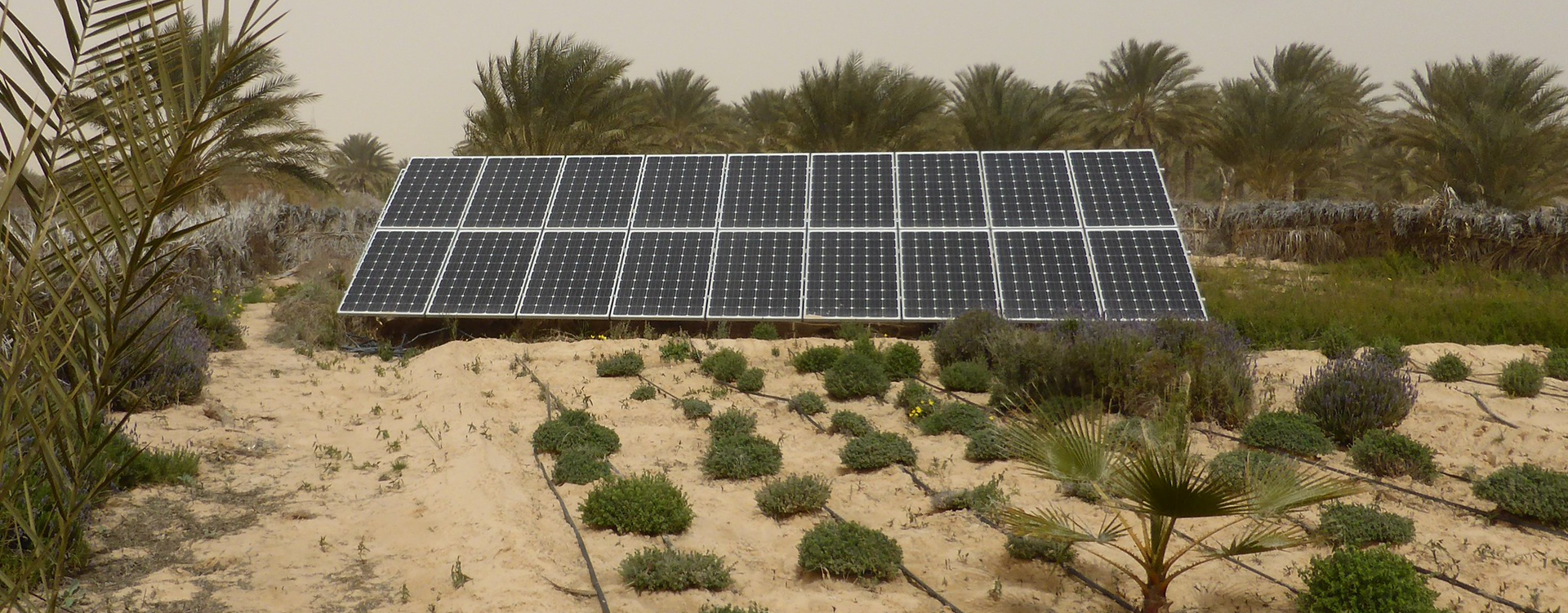Will Tunisia’s 2050 energy plan deliver primary energy self-sufficiency?

Tunisia needs more than solar and wind energy to achieve sustainable full energy self-sufficiency.
Tunisia is embarking on an ambitious long-term clean energy transition, anchored in the rapid development of solar and wind projects. In Tunisia, over 95% of electricity generation relies on gas, while all renewable sources—hydropower, solar, and wind—combined account for about 4% only (Figure 1). The national energy plan aims to increase this share to 35% by 2030, and at least 80% by 2050. In the medium term (by 2035), Tunisia targets to generate half of its electricity from clean energy sources, accounting for 18% of the country’s primary energy mix.
The plan facilitates a swift transition from fossil fuel dependency to clean energy. Meanwhile, the country imports 62% of the natural gas it uses for electricity generation. Therefore, beyond the obvious climate-related benefits of clean energy, Tunisia’s national energy plan also aims to provide economic relief by gradually reducing costly gas imports.
In 2023, gas and oil imports constituted more than half of Tunisia's trade deficit, representing over 7% of the country's Gross Domestic Product. This situation drains the country's foreign currency reserves, exposes it to volatile global energy prices and further undermines its fiscal stability.
This energy plan is also key to upholding the country's electricity self-sufficiency, especially as demand continues to rise due to both economic activities and population growth. Between 2000 and 2021, Tunisia’s electricity demand grew by almost 4% annually. This growth necessitates robust electricity generation and saving initiatives to avoid the unfavourable electricity balance experienced between 2003 and 2006 (Figure 2, left part).
While Tunisia maintains a broadly favourable electricity balance, the country struggles with a large and volatile primary energy deficit, a gap that reached 56% in April 2024, with energy self-sufficiency tumbling from 51% in April 2023 to just 44% (Figure 2, right part). This divergence highlights a central challenge in Tunisia’s energy sector: although electricity supply is stable, overall primary energy production is stagnating, even as demand continues to rise. The critical question emerges: Can Tunisia’s 2050 energy plan bridge this growing gap, addressing structural deficits while maintaining its electricity security? In this regard, part of the country’s energy plan aims to reduce energy consumption by approximately 44 million barrels of oil equivalent (BOE) by 2030 through various efficiency measures.
Tunisia’s energy transition plan demands significant capital mobilisation, with an estimated US$18 billion required by 2035, which is expected to generate around 70 000 direct and indirect jobs in the energy sector. To fully realise the plan’s 2050 objectives, a cumulative investment of approximately US$43.5 billion will be needed, translating to US$1.5–2 billion annually over the next 25 years.
The Tunisian government aims to secure 66% of this financing through public-private partnerships (PPPs), a strategy that hinges on establishing a stable, transparent and investor-friendly policy environment. The remaining funding will be sourced from Development Finance Institutions (DFIs) on concessional terms, alongside national budget allocations, international climate funds, and bilateral support, particularly from the European Union and Gulf states.
This optimistic vision, however, confronts a complex reality. Tunisia faces chronic fiscal deficits, deteriorating governance and substantial energy subsidies, which have led to a growing public debt. At the same time, its growing energy demand continues to place additional pressure on the energy system. These headwinds raise another critical question: Can Tunisia successfully mobilise the scale of investments and implement the deep reforms necessary to achieve its national energy plan?
Large-scale energy infrastructure investment and leapfrogging interventions form the backbone of Tunisia’s energy plan. Their transformative impact is maximised when integrated with strategic governance reforms, attracting larger financial inflows, investment in education and health, ensuring an agricultural revolution, growing its manufacturing sector and regional trade, particularly through the African Continental Free Trade Area (AfCFTA). The AFI-ISS study's high-growth scenario illustrates how such synergistic interventions can drive Tunisia’s structural transformation pathway, making the energy transition not only a climate imperative but a development catalyst.
Tunisia’s energy outlook to 2043
The study models Tunisia’s annual energy production which almost doubles by 2043 under a high-growth scenario (Figure 3). This growth is primarily driven by a substantial scale-up of solar and wind energy, aligning with the national strategy to transition from fossil fuels to renewable sources. By 2035, solar and wind will each contribute around 25% of total energy production. Looking ahead to 2043, solar’s share will rise further to 40%, while wind stabilises at around 20%, underscoring the central role of renewables in Tunisia’s long-term primary energy mix.
At the same time, energy demand will grow faster (Figure 3). Under both a high-growth and business-as-usual scenario, the country’s energy deficit will still widen significantly, with only a slight improvement under the former.
Overall, the AFI-ISS study shows that Tunisia is well-positioned to achieve the targeted 18% share of renewables in its primary energy mix by 2035 and to deliver at least 60% green energy by 2043 under a high-growth scenario. However, to meet domestic demand, it may still need to import around 60% of its energy by 2035 and nearly 80% by 2043.
Therefore, these findings serve as a reality check on Tunisia’s 2050 vision: solar and wind energy alone cannot deliver energy self-sufficiency in the short and long run. Complementary solutions must be considered, including reconsidering stalled options like nuclear power or geothermal energy to help diversify the energy mix and ensure a reliable baseload supply.
Tunisia will achieve its targeted 18% renewables share in primary energy mix by 2035 under a high-growth scenario, but must invest beyond solar and wind to deliver energy self-sufficiency
Tunisia had explored nuclear energy in the past, even training atomic engineers, but plans were halted due to costs and political concerns. Reviving its nuclear ambitions, considering small-scale modular units or tapping into geothermal sources in the southern part of the country, could help bridge the energy supply gap. However, these options come with long lead times and steep investment needs.
Another implication of these findings is that demand-side management must play a bigger role. Tunisia cannot simply build its way out of this gap by amplifying production; it must also tackle consumption through efficiency, pricing reforms and technological changes. That includes phasing out wasteful energy subsidies that encourage over-consumption of electricity, gas and oil. It also means modernising its grid, investing in storage to handle intermittent renewables efficiently and promoting electrification of transport and heating in tandem with clean power so that demand growth is met smartly. The high-growth scenario envisions some of these interventions; however, the energy deficit by 2043 suggests that more aggressive interventions, including widespread energy-efficient appliances, building retrofits and demand response systems, may be required to bend the demand curve downward.
The high-growth scenario also highlights climate- and economic development-related benefits if Tunisia effectively implements reforms. Because of the investments in renewables by 2043, carbon emissions would be lower and economic outputs higher compared to the baseline trajectory. This underscores the apparent benefits of the green energy transition: Tunisia can make progress toward its climate commitments (Paris Agreement/NDC targets) while also stimulating growth.
However, without integrating climate resilience into all development domains, there is a risk that economic expansion will simply increase emissions, as seen in the study, where trade and manufacturing growth result in higher energy use and emissions in the absence of green policies.
Without robust efficiency reforms, Tunisia risks replacing energy deficit with energy dependency, trading gas for intermittency and emissions for imports
The takeaway is clear: Tunisia’s future prosperity is intertwined with a green energy transition. However, closing the gap between energy demand and supply will require major leaps in renewable deployment and efficiency beyond current plans.
Image: Water Alternatives/Flickr
Read the recently updated full country analysis of Tunisia here.






